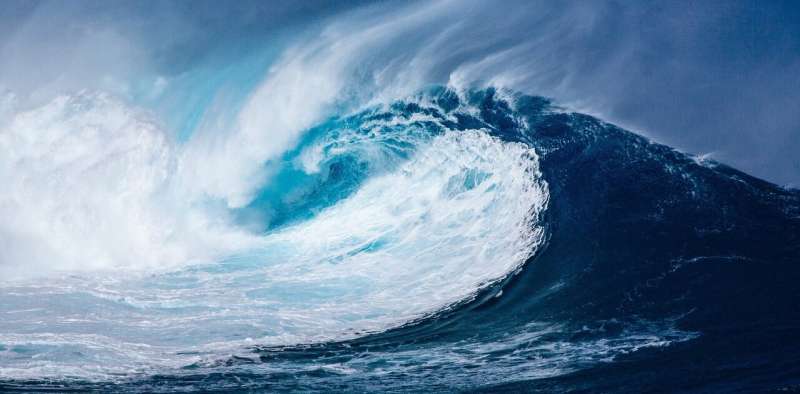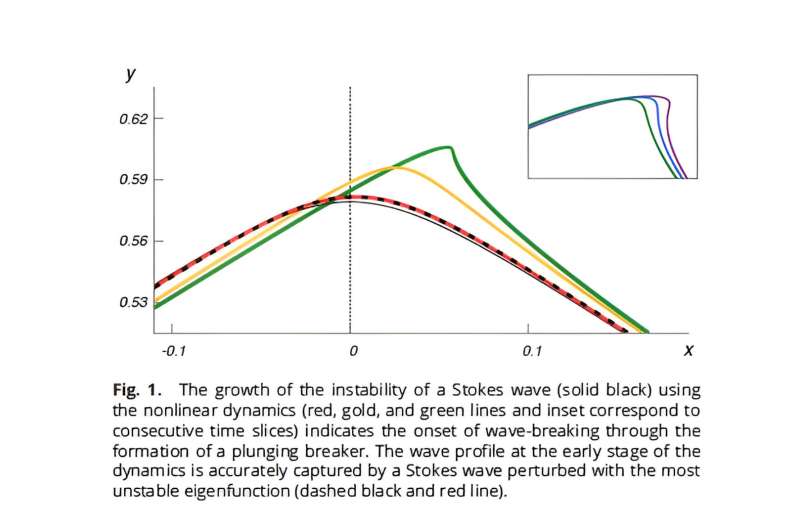This article has been reviewed according to Science X's editorial process and policies. Editors have highlighted the following attributes while ensuring the content's credibility:
fact-checked
peer-reviewed publication
trusted source
proofread
Oceanic waves represent fundamental challenges in nonlinear science, say mathematicians

The instability of Stokes waves (steady propagating waves on the surface of an ideal fluid with infinite depth) represents a fundamental challenge in the realm of nonlinear science. A team of researchers recently identified the origin of breaking oceanic waves in a recent publication in the Proceedings of the National Academy of Sciences.
The research includes two graduates from the UNM Department of Mathematics and Statistics: former students Sergey Dyachenko (now an assistant professor in the Department of Mathematics at the University of Buffalo) and Anastasiya Semenova (now a postdoctoral researcher in the Department of Applied Mathematics at the University of Washington). The team also included Professor Bernard Deconinck from the Department of Applied Mathematics at the University of Washington and UNM Distinguished Professor Pavel Lushnikov.
Steady propagating surface gravity waves, discovered in the 19th century by Stokes, are the key structure of ocean swells easily seen from beaches, airplanes, and ocean liners. Lushnikov explains, "A Stokes wave is a surface gravity wave that propagates in the ocean with a constant velocity and is spatially periodic in the direction of propagation."
The dominant instability of these waves depends on their steepness. Lushnikov further explains, "We studied the instability of large amplitude gravity waves on the surface of the ocean. The tallest such waves have eluded analysis, and their dynamics remains largely unexplored which motivated our study."
Since the 1960s, the Benjamin-Feir or modulational instability has dominated the dynamics of small-amplitude waves, resulting in a slow variation of the swell. The team demonstrated that, for steeper waves, another instability caused by disturbances localized at the wave crest significantly surpasses the growth rate of the modulational instability.

"Benjamin-Feir or modulational instability characterizes the growth of disturbances of small amplitude Stokes waves. That instability has the spatial scale greatly exceeding the spatial period of Stokes wave. Disturbances in that case grow on the temporal scales greatly exceeding the temporal period of Stokes wave," said Lushnikov. "We used mathematical techniques of conformal mappings and developed a new matrix-free approach to address the large-scale eigenvalue problem. These tools allow us to reveal the nature of the instability of Stokes waves."
These dominant localized disturbances are either co-periodic with the Stokes wave or have twice its period. In either case, the nonlinear evolution of the instability leads to rapid formation of plunging breakers destroying steep waves. This phenomenon explains why long-propagating ocean swell consists of small-amplitude waves. The breaking of oceanic waves provides a key mechanism for the exchange of energy between atmosphere and oceans, significantly affecting the global climate dynamics.
"The sun heats the atmosphere, which then transfers energy to the oceans, heating them. The direct transfer of energy through thermal conductance and friction between air and water are relatively small. Instead, if the surface gravity wave breaks, it transfers most of its kinetic energy into small spatial scales eventually transforming that energy into heating of the ocean water. Global climate dynamics are determined by the interaction of atmosphere and oceans."
The research team successfully uncovered the pivotal mechanism driving the captivating spectacle of large ocean wave breaking. Through their rigorous investigation, they've identified the crucial role played by fast wave breaking in shaping the composition of long-propagating ocean swells. This newfound insight sheds light on why these expansive swells are primarily comprised of small-amplitude waves. By delving into the heart of this phenomenon, the team has not only revealed a fundamental aspect of wave dynamics but also deepened the understanding of the intricate forces at play with Earth's ocean.
Lushnikov concludes, "We found the dominant mechanism of the fascinating phenomenon of breaking of large ocean waves. Fast wave breaking found by us explains why long propagating ocean swell consists of small-amplitude waves."
More information: Bernard Deconinck et al, The dominant instability of near-extreme Stokes waves, Proceedings of the National Academy of Sciences (2023). DOI: 10.1073/pnas.2308935120
Journal information: Proceedings of the National Academy of Sciences
Provided by University of New Mexico





















